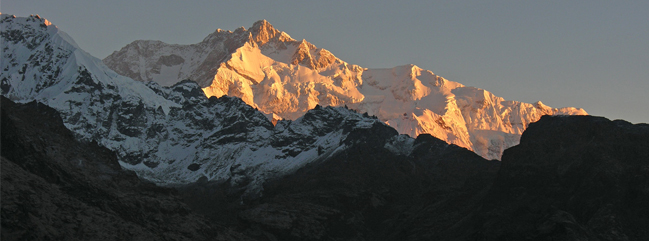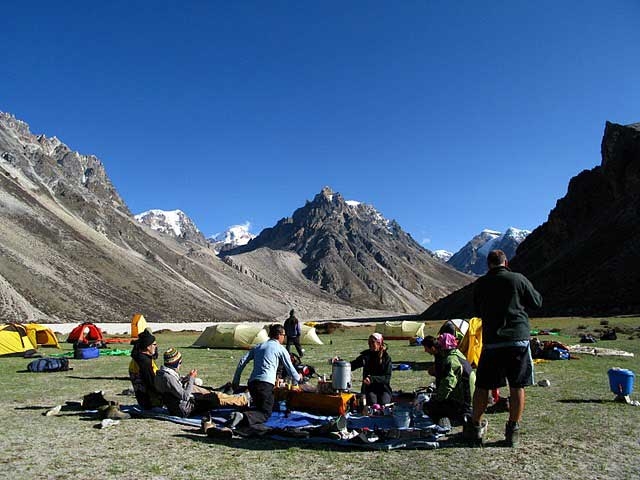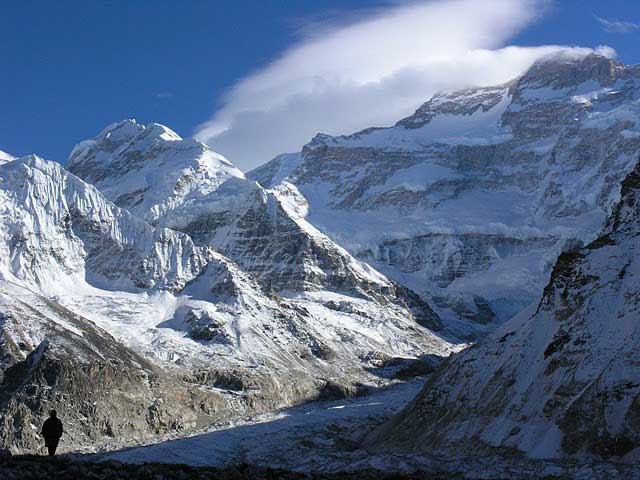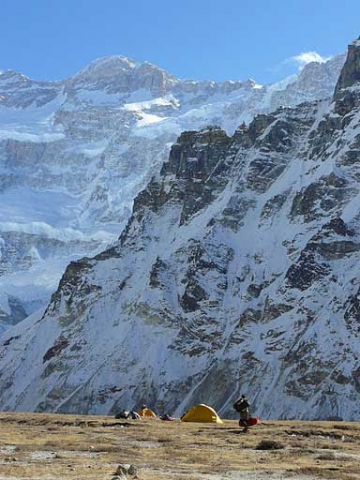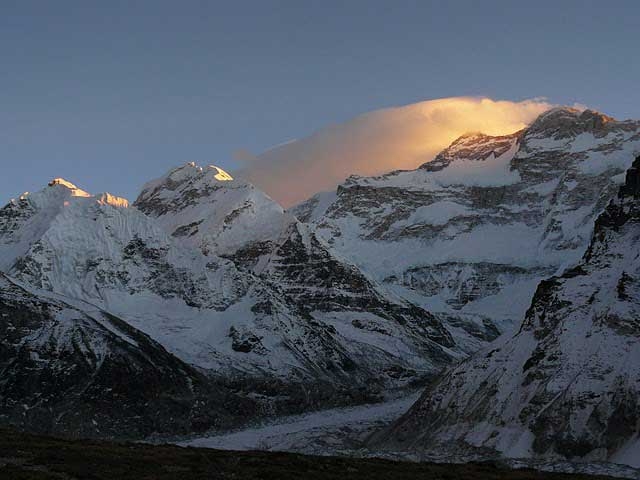“Kang-chen-zod-nga”, meaning “Five Great Treasuries of the Snow”, actually it has seven major summits. To the locals Kanchenjunga which stands at a height of 8585meters the third highest mountain in the world, is the abode of gods who bestow prosperity and goodwill on them and their lands, while to the climbers of this mountain the phrase “Five Great Treasuries of the Snow” takes on a slightly more ominous tone. The avalanches that Kanchenjunga throws down are said to be the largest anywhere!
Since the locals worship the mountain, there is a tradition among mountaineers not to stand on the actual summit. All “successful” assaults have stopped just short of the summit honouring an old promise made by the leader of the first successful attempt in 1955 to the maharaja of Sikkim.
Kanchenjunga lies on the eastern border of Nepal providing a great chance to experience remoteness, spectacular mountain scenery, diverse flora and fauna and rich local culture, quite different to those found further west.
We begin the journey to Kanchenjunga with a flight from Kathmandu to Taplejung (Suketar). From Suketar the trek leads to Chauki through the villages of Mitlung, Ghunsa, Khambachen and Lhonak to Pangpema (5140 meters) which is also the Base Camp for expeditions attempting the North Face of Kanchenjunga 2 and the culmination of the first part of the trek.
Day 01- Arrival in Kathmandu airport (1345meters).
There you will be met by our Airport Representative and transferred to hotel by private tourist vehicle. Overnight at hotel.
Day 02- Pre-trip Meeting and Sightseeing around Kathmandu valley.
In the morning after breakfast at 9 AM, we host a Pre-Trip meeting at your hotel in Kathmandu and introduced your trek Leader/Guide mean time and it will provide an opportunity for individuals to ask questions about the your trek and to introduce you to other participants. This includes a final briefing and preparations for the trip.
PLEASE ADVISE US IF YOU WILL BE ARRIVING LATE AND ARE THEREFORE UNABLE TO ATTEND THE PRE-TRIP MEETING.
In THE PRE-TRIP MEETING All passengers MUST bring:
1. Passport.
2. Four copies of Passport size photos each.
3. Travel Insurance Policy.
4. A writing pen
5. Notepad.
After the Pre-Trip meeting and breakfast your sightseeing trip will start at 9.45 AM in the morning. We provide a private vehicle and professional tour guide. We visit Bodhnath Stupa, one of the biggest Buddhist shrines in the world, where we observe Buddhist monks in prayer in the monasteries surrounding the stupa. After Bodhnath Stupa we visit Pashupatinath, the most famous Hindu temple in the country, located on the banks of the holy Bagmati River. Here we see Hindu holy men (sadhus) meditating, pilgrims bathing and occasionally funeral pyres burning on the ghats. We also visit Bhaktapur Durbar Square, which is a collection of pagoda and shikhara – style temples grouped around a fifty-five-window palace of brick and wood. The attraction of the Bhaktapur Durbar Square is The Lion gate, The Golden gate, The Palace of fifty five windows, Art Galleries, The Statue of King Bhupatindra Malla.
The rest of our time in Kathmandu is free for further exploration and some last-minute shopping in Thamel area near by your hotel. Later, we are supplied with our Trek Pack and departure information for tomorrow. Overnight at hotel.
Day 03- Fly from Kathmandu to Taplejung (2320meters) trek to Lali Kharka (2276meters) 3 hours.
Half hour flight to Taplejung at Suketar Airport. The porters and crew will be waiting for our arrival. After landing we take an early lunch, while the crew arranges our gear. In the afternoon we start with an easy 2 to 3 hours walk along the ridge line to Lali Kharka, a grazing area. Overnight at tented camp.
Day 04- Trek to Khesewa (2120meters). 5 hours
After traversing the hillside a short way, we descend to the village of Pakora along the Phawa Khola, crossing a suspension bridge before beginning the steep climb up towards Kunjuri. Lunch will be taken somewhere below Kunjuri. The afternoon’s walk takes us on a short distance over the crest of the ridge to our campsite at Khesewa. We get our first views of Kanchenjunga, and should be able to clearly make out the south and main summit along with Yalung Kang. Overnight at tented camp.
Day 05- Trek to Mamankhe (1920meters). 5 hours.
Today the path covers steep hillside through terraced fields high above the Kabbeli Khola. There are some ups and downs crossing side valleys but there are many shady spots to rest. After lunch, we pass the village of Anpan, before descending to cross the Kashawa Khola and finally, we climb again through terraced fields to the village of Mamankhe. Overnight at tented camp.
Day 06- Trek to Yamphudin (2080meters) 6 hours.
Today the walk start with an easy climb to Yamphudin along a track which contours the hillside above the Kabeli Khola. The path has several ups and downs as we cross the ridges and stream beds that make up the valley sides. Generally the route is flat and the river eventually becomes level with the trail, a couple of hours before Yamphudin. At last we can stop to bathe in one of the clear pools within this beautiful river. It is truly an idyllic spot. After lunch by the river we complete the day’s walk to Yamphudin. Yamphudin is the most remote settlement in this area and the last village we will see until we reach Ghunsa. It is a charming place tucked away beneath the ridge of Deurali Danda that we must cross next. Overnight at tented camp.
Day 07- Trek to Chitre (2965meters) 5 hours.
Beyond Yamphudin the trail ascends a steep spur, a gentle introduction for what will come. Leaving villages behind we trek through pleasant forest, stopping for lunch in a meadow capturing fine views of the north and south. A steep descend to the river an interesting bridge across the Omje Khola to our campsite in Chitre. Overnight at tented camp.
Day 08- Trek to Tortongn (3010meters) 6 hours.
Starting the day with 3 hours of steep ascent to the crest of the Deurali Danda in dense forest most of the way. From the 3230meters pass we see Jannu, definitely closer! We descend across some steep and exposed areas before entering the forest again. The sharp descent through beautiful forest continues down into the valley of the Simjua Khola. Across the ‘interesting’ wooden bridge is Tortongn, a camping place with numerous rock shelters amid towering conifers. The steep hills make today a tough 6 to 7 hours trekking. Overnight at tented camp.
Day 09- Trek to Tseram (3870meters) 6 hours.
Today we follow the river through more beautiful forest, the conifers giving way to the rhododendron forest. The valley climbs fairly steeply, with the day progressing the trees become more stunted and scattered, giving us glimpses of the snow-capped giants ahead and the massive snout of Yalung Glacier. Just before Tseram the towering heights of Kabru and Rathong peak start to peep over the moraine. Camping at Tseram, a grazing area, the night temperatures will remind us that we are really gaining height. Overnight at tented camp.
Day 10- Trek to Ramche (4580meters) 4 hours.
A shorter day’s walk up the final 600 meters to Ramche where the trail to Kanchenjunga South turns dangerous. The scenery is magnificent as we ascend past the snout of Yalung Glaciers into a series of ablation valleys, which gives easy walking and good camping. A frozen lake, clear streams and views of Koktang, Rathong and Kabru are the highlights of this stroll. Expect to feel the altitude today. Overnight at tented camp.
Day 11- Explore around Ramche (4580meters) and trek to Oktang (4730meters) 5 hours.
Our first close encounter with Kanchenjunga. Following the valley round to see the stunning south face of Kanchanjunga and Jannu. We get across the Yalung Ri Glacier and continue by a sweeping curve, at Oktang, 4730meters, suddenly we are confronted with the southern wall of the mountain. This vast ridge forms a cirque over 15 kms long, nowhere less than 7500meters high and with three main summits of Kanchenjunga at 8420meters, 8586meters, and 8474meters! It is a breathtaking mountain panorama and especially impressive is Jannu while observing the glaciers flowing from its east face. Overnight at tented camp.
Day 12- Trek to Yalung Ri Base Camp (5400meters) 5 hours.
This extended part will take you to the high altitudes. It requires determination. The crossing of high passes requires good weather, and of course perfect logistic support. Expect to get acclimatized with the altitude today. Overnight at tented camp.
Day 13- Trek back to Ramche (4580meters) 5 hours.
Yalung Glaciers and a series of valleys, give good walking and perfect camping. A frozen lake, clear streams and magnificent views are the highlights of this stroll. Overnight at tented camp.
Day 14- Trek to Sallerle over the Mirgin La (4480meters) 6 hours.
We trek down the valley, passing the turn off to the high and challenging Labsang La route to Ghunsa and the north side of Kanchenjunga. This pass is rough and dangerous, especially for porters so we take the more southern set of passes, beginning with the Mirgin La. After an initial steep climb and several false summits we reach Mirgin La. Apart from the magnificent Jannu, on the horizon are Makalu, Gyakung Kang, Everest, Lhotse and Chamalang. To the south it is possible to see down to the Terai, a panorama worth the effort. Our campsite will be beyond the pass, after 6 to 7 hours tough walking. Overnight at tented camp.
Day 15- Trek to Ghunsa (3475meters) 5 hours.
Although there four more passes, there is little descent between them, so in effect it is a high scenic area. After lunch the descent brings us to Lamba Sumba Kharka, where there are more views of the awesome Southwest Face of Jannu. From Kharka the going is easy again down a pleasant forested trail to the village of Ghunsa, where we camp in the village. Ghunsa is a picturesque Tibetan village; prayer flags flutter from the wooden houses and there are two monasteries, a welcome sight after the many days of wilderness. One of the local specialties’ is ‘Tongba’, a curious alcoholic drink. A jug or large bamboo cup is filled with fermented millet seed and boiling water pored over. The flavour and alcohol seep though and you drink it with a special straw. You might need a drink after the tough 4 to 6 hour walk. Overnight at tented camp.
Day 16- Trek to Kambachen (4040meters) 6 hours.
Gradually the trail ascends to south of the Ghunsa Khola and crossing flood plains while emerging on a pasture situated at the north side of the river. A steep climb to a slope from where it crosses a slide and then descends to Lakepo. A short climb from here to the village of Kambachen 4040meters. Overnight at tented camp.
Day 17- Exploration day at Kambachen.
Today we spend acclimatizing to high altitude. It also doubles up as a rest day and can be used for a short morning hike to explore the area around Kambachen. Those who feel the urge should be able to catch up on their laundry. Otherwise, a good book should get you through the day perfectly. It is essential to acclimatize to the higher altitude as you have been spending a lot of time at lower altitudes.
From here there are good mountain views of the peaks near Kanchenjunga which are visible. You can hike up the ridge above the village for better views or take a day hike to Jannu Base Camp. The Nepali name for Jannu is Kumbakarna. Overnight at tented camp.
Day 18- Trek to Lhonak (4790meters) 6 hours.
A gradual climb through rocky fields gets you to Ramtang at elevation of 4240 meters then crossing northwest of the Kanchenjunga Glacier you reach Lhonak. Lohnak is on a sandy plain near a dry lakebed. You will camp between the boulders here to stay out of the wind. There are beautiful mountain vistas all around. Water is very scarce in Lhonak and you will need to use only as much as absolutely necessary. Overnight at tented camp.
Day 19- Trek to Pang Pema (5140meters) 4 hours.
The main Kanchenjunga peak is only visible from Pang Pema, which is the base camp for expeditions on Kanchenjunga. From Lhonak, the trail gradually ascends across the plain but soon gets steeper as it follows the moraine. Pang Pema is at a height of 5140 meters. Overnight at tented camp.
Day 20- Explore around Kanchenjungha Base Camp (5100 meters) and retrace your steps to Kambachen 5 hours.
Today those who would like to take a morning hike up a ridge, north of Pang Pema. A climb of 200 or 300 meters providing a great vantage point with views of Kanchenjunga, Wedge Peak, the Twins and Tent Peak. As usual the descent goes faster and you can reach Kambachen the same day. Overnight at tented camp.
Day 21- Trek to Ghunsa 6 hours.
More descents thru magnificent sections of forest as long as we make Amjilosa tomorrow. From Ghunsa an hour down we pass through Phole, a village in two parts. The upper section houses Tibetan refugees who are well established, the second is the winter village of Ghunsa. Further down is Yangswa, a great and warm camp. Overnight at tented camp.
Day 22- Trek to Amjilosa (2460meters) 4 hours.
Initially we pass thru beautiful forest opening out to steep, grassy hillsides where Amjilosa is perched. Overnight at tented camp.
Day 23- Trek to Sakathum (1600meters) 5 hours.
Down, down and down! After a short climb we begin the steep descent that will take most of the day. We reach the joining of the Tamur and Ghunsa Kholas. Overnight at tented camp.
Day 24- Trek to Chhiruwa (1200 meters) 5 hours.
We cross the Simbu Khola, which originates from Kanchenjunga’s south base camp, the Khola that we followed up from Torontan. It is pleasantly warm at these low altitudes and cardamom grows freely in the moist shaded forest. Crossing numerous small tributary streams we reach Chhirwa, a village set among large boulders. We camp in a field out of the village. This is an easier day. Overnight at tented camp.
Day 25- Trek to Suketar (2420meters) 5 hours.
Traversing in an out of minor valleys, we pass thru a succession of picturesque villages on our way to Suketar, reaching around late afternoon. Overnight at tented camp.
Day 26- Fly back to Kathmandu.
Enjoying your last glimpse of the mountains you have recently visited one last time on the 35 minute Scenic flight back to Kathmandu. Overnight at hotel.
Day 27- Leisure day in Kathmandu.
It’s also spare day in Kathmandu, if you are interested in continuing onto Chitwan Jungle Safari, River Rafting Adventure, Kathmandu Shopping Tour or Scenic Everest Flight.
Day 28- Transfer for your final flight departure.
The trip ends, our Airport Representative will drop you to the Kathmandu International Airport for your flight departure from Nepal.
NOTE: The above information is a guide and standard template of what we provide. The trek can be customized at your request to accommodate your specific requirements.
Note : On adventure trips of this type, weather, local politics, transport or a multitude of other factors beyond our control can result in a change of itinerary. It is, however, very unlikely that the itinerary would be substantially altered; if alterations are necessary the leader will decide what is the best alternative, taking into consideration the best interests of the whole group. Where a change does occur, we do everything we can to minimize its effect, but we cannot be responsible for the results of changes or delays.
Q.What type of shape do I need to be in, is this trip for me?
A. Trekking is suitable for average people who are moderately fit, thus no previous experience is required. Some physical fitness programs such as running, swimming, hiking is recommended before you embark on your journey. Persons suffering from a pre-existing medical condition or disease must seek medical advice before considering the trek. Whilst on the trek, it is common to experience some discomfort before being fully acclimatized.
To prepare for a strenuous trek you should begin training at least two to three months before your departure. As a guideline, an hour of aerobic exercise three to four times per week would be considered a minimum requirement. The best preparation is bushwalking involving relatively steep ascents and descents. If you can manage a couple of valley floor to ridgeline ascents per comfortable and able to enjoy the trek to the fullest. They are physically strong, sharp-witted and have an incredibly positive attitude towards a life that we would consider extremely tough. There is something about a trek in the Himalaya that draws you back time and time again. For keen walkers it is a paradise and even avowed non-walkers find that one foot just seems to follow the other, drawn by the appeal of what lies beyond.
Q. Will somebody come to pick me up at the Airport upon my arrival?
A. Yes, our Airport Representative will be there to greet you outside of Terminal Hall, he/she will be displaying an Kiwi Adventures Treks & Expedition sign board. Upon arrival, you will be transferred to your hotel.
Q. What sort of accommodation can I expect in Kathmandu and in trekking?
A. 11 night’s Trekking Guesthouse, 4 nights three/four star hotels in Kathmandu.
We use standard rooms from three/four star hotels in Kathmandu with breakfast included. Along the trekking routes teahouses/Lodges generally provide basic clean facilities with a mattress and a quilt or blanket. We can also offer you sleeping bags if needed (which need to return after the trip) but it is a good idea to always have your own sleeping equipment. We usually provide single and double rooms as well as the occasional dormitory. The dining room is downstairs around a fire. All food will be cooked to order in the little kitchen. You should not enter the kitchen unless asked to do so.
Q. What sort of food can I expect in trekking?
A. In trekking most teahouses (lodges) cook a delicious range of mostly vegetarian fare. Pasta, tuna bakes, noodles, potatoes, eggs, dhal bhat, bread, soups, fresh vegetables (variety depends on the season) and even some desserts like apple pies, pancakes, and some interesting attempts at custard. You will find a lot of garlic on the menu because it assists with acclimatization – eat some every day. In many larger villages you may find some meat on the menu. You can always get hot chocolate, tea, and hot lemon drinks, as well as soft drinks, and treats like chocolate and crisps.
Each day dinner and breakfast are used to take in the same lodge you spend the night. Lunch will be taken on the way to destination.
Q. What sort of transportation you use?
A. Kiwi Adventures Treks & Expedition is all about providing you with local insights as well as adventure, with that in mind, where we think you will get more out of your holiday by using different means of transport that is what we do. Using a variety of private transport is an integral part of our Himalaya tours and enhances the experience!
We use private tourist vehicles for sightseeing, city tours and pickups. Depending on the group size we use cars, minibus, van or land cruiser. These small light vehicles are more manoeuvrable and flexible enabling us to take you through the Narrow roads of Nepal. All the vehicles are usually air-conditioned unless we are travelling in cooler areas.
Q. What is the best season for this trekking?
A. Our trekking season extends from mid- September to May. From early September the monsoonal rains decrease. By end of September through to December the weather is usually stable with mild to warm days, cold nights. February, March, April, May, October, November, December are the best time to do trek.
Q. What is the weather & temperature like in trekking?
A. Weather in the mountains is notoriously difficult to predict. At night it is generally cooler the days are generally warm. Winter (January and February) will be bit colder but the days can be quite beautiful and warm if the sun is out. There will be bit of snow during the month of January, February and December. It is also important to make sure that you can stay warm and dry in just about any conditions. Expect the unexpected! The temperature could be as high as 20 deg C to -15 deg C low.
Q. Can I charge my digital camera or other batteries on my trip?
A. These facilities will be available in most of the places in your hotel reception by paying some service charges. Remember to bring your adapters!
Q. Is there any communication while we are on trekking?
A. There are telephones in some villages along the trekking routes from which you can make international calls.
Q. Can I use credit cards in the places visit in trekking?
A. In most cities yes, to some extent, however once you leave those cities behind, all you need is cash.
Q. How much additional money do I need per day?
A. In Kathmandu, you can allocate US$ 10 – 25 for a lunch / dinner. It’s all depends on your spending habits. US$7 to 10 US$ a day will be enough to buy bottles of water, chocolates and few drinks in trekking.
Q. Do I need to tip my guide and porters? How much would that be?
A. This is a difficult thing to gauge. We have seen everything from 20USD to 1000 USD per person for guides and porters. Tipping is not required, but a small way to show your guides and local porters thanks for their help. The level of the tip should reflect the level of personal involvement with your guide.
Q. Is the water OK to drink? Do I need to bring purifying tablets/filter?
A. In most places bottled water is readily available. If you wish to drink normal water, you need to use purifying aid, which you will need to bring with you.
Q. Are the Kiwi Adventures Treks & Expedition staff insured?
A. Our company insures all our trekking staff, including guide, cook, sherpa and porters.
Q. What essential documents do I need to bring with me on tour?
A. *Valid Passport – must be valid for up to 6 months after you return from your tour, keep a separate photocopy.
*Travel insurance, keep a separate photocopy
*Cash and Traveller’s Cheques, keep numbers and proof of purchase separate
*Flight tickets
*Emergency contact numbers for T/C’s, banks, insurance, family contacts.
Q. Can I add extra days to my trekking trip?
A. A hoilday should never be about making it to the final point quickly. Along your trek we can add days at your request with additional costs to cover guides, porters, accommodation and food.
Q. Do you use yaks/porters on the trek or do we carry all of our own gear?
A. Whilst on the trek, our porter will take care of your luggage. All you need to carry is your small day bag for your personal belongings like camera, water bottle, sun cream etc only.
Q. What opportunities will I have for shower along the trek?
A. In major places, we arrange guesthouse with hot shower. And in rest of the places, hotel water in bucket will be provided for shower; it would cost you extra about USD 3-4 per shower.
Q. Do you know about how many total miles the trek is?
A. Total distance of the entire trek is about 75 miles.
Cost Includes
• Airport / Hotel / Airport pick up & drop by private car / van / bus.
• Standard twin sharing accommodation in four/five star hotel in Kathmandu breakfast included.
• Sightseeing/Monument entrance fees.
• Guided city tour in Kathmandu by private car / van / bus.
• Full board meal during camping, prepared by our cook with Tea & coffee.
• Tented accommodation and equipment during the camping trek. (We will provide fully water proof two men tents, dining tents, kitchen gear, dining table, chairs, toilet tents, shower tent etc.)
• A government licensed English speaking Guide during the trek. A cook and the required number of porters, their food, accommodation, salary, insurance, equipment and medicine.
• Boiled and purify drinking water for the trek.
• All special trekking permits & fees.
• Surface Transfer to and from Kathmandu.
• Flight cost from Kathmandu – Taplejung – Kathmandu including airport departure taxes in both airport.
• All our government taxes.
• Tourist service charge, vat.
• Official expense.
Cost Excludes
• Lunch and dinner whilst in Kathmandu.
• Your travel insurance (compulsory).
• International airfare and airport departure tax.
• Nepal entry visa, you can obtain a visa easily upon your arrival at Tribhuwan International Airport in Kathmandu. (US$ 25 or equivalent foreign currency is required to obtain Tourist Visa with Multiple Entry for 15 days. Likewise, Tourist Visa with Multiple Entry for 30 days can be obtained by paying US $ 40 or equivalent foreign currency. Similarly, Tourist Visa with Multiple Entry for 100 days can be obtained by paying US $ 100. You will also require 2 passport size photos.)
• Items of a personal nature such as alcoholic drinks, cold drinks, laundry.
• Personal trekking Equipment.
• Tips for trekking staff. (Tipping is expected.)
• Any others expenses which are not mentioned on Price Includes section.
